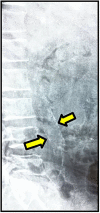Association of Serum Osteoprotegerin Level With Myocardial Injury and Cardiovascular Calcification in Chronic Kidney Disease Patients
- PMID: 35814784
- PMCID: PMC9257085
- DOI: 10.3389/fmed.2022.814970
Association of Serum Osteoprotegerin Level With Myocardial Injury and Cardiovascular Calcification in Chronic Kidney Disease Patients
Abstract
Background: Chronic kidney disease has emerged as a significant independent risk factor for cardiovascular disease. Cardiovascular calcification is an active process involving a complex interaction of inducers and inhibitors. High sensitivity cardiac troponin T assay detects troponin T with higher sensitivity and precision at an earlier point of time than the conventional assays, and is associated with poor outcomes. Serum osteoprotegerin is classed as an inhibitory factor for cardiovascular calcification. It is involved in the pathological processes of vascular damage and linked to the excess cardiovascular morbidity. The aim of the present study was to evaluate the extent of cardiovascular calcification and serum high sensitivity cardiac troponin T level, and their association with serum osteoprotegerin level in patients with chronic kidney disease stages 3-5.
Methods: 90 chronic kidney disease patients were enrolled in this study, and they were divided into two groups: group (1) included 45 non-dialysis-dependent chronic kidney disease patients (stages 3-5) and group (2) included 45 chronic hemodialysis patients. Each group further subdivided according to the presence of cardiovascular calcification into subgroup A and B. Vascular calcifications were assessed by lateral lumbar, pelvis and hands X-ray radiographs. Valvular calcification was assessed by echocardiography. Serum cardiac troponin T was measured by high sensitivity assay and serum osteoprotegerin was measured by ELISA.
Results: Cardiovascular calcification distribution was 22.2% in group (1) and 33.3% in group (2). Serum osteoprotegerin and troponin T in calcification groups (1A and 2A) were significantly higher than non-calcification groups (1B and 2B; P < 0.001). Osteoprotegerin correlated positively with high sensitivity cardiac troponin T (rs = 0.72, P < 0.001). cardiovascular calcification correlated positively with osteoprotegerin, troponin T, and phosphorus. osteoprotegerin and phosphorus were significant independent predictors of cardiovascular calcification at cut-off values ≥4.6 ng/L and ≥6.95 mg/dl, respectively (P < 0.001). Serum phosphorus and creatinine were independent predictors of osteoprotegerin (P < 0.001 and 0.048, respectively).
Conclusion: Osteoprotegerin is strongly associated with cardiovascular calcification and high sensitivity cardiac troponin T. In addition, there is a positive association between calcification and troponin T. This suggests a role for osteoprotegerin in the pathogenesis and risk stratification of cardiovascular calcification and myocardial injury in chronic kidney disease patients with a potential role as a therapeutic target.
Keywords: cardiovascular calcifications; chronic kidney disease; myocardial injury; osteoprotegerin; troponin T.
Copyright © 2022 Okasha, Aboufreikha, Elrefaey, Ashmawy, Mourad, Elsebaey, Elnaggar, Mashaal, Metwally, Mashal, Shalaby, Elhoseny, Alkassas, Elbarbary, Shoeib, Ali, Baiomy and Alnabawy.
Conflict of interest statement
The authors declare that the research was conducted in the absence of any commercial or financial relationships that could be construed as a potential conflict of interest.
Figures





Similar articles
-
Relationship between serum osteoprotegerin and vascular calcifications in hemodialysis patients.Egypt Heart J. 2017 Jun;69(2):149-155. doi: 10.1016/j.ehj.2017.02.004. Epub 2017 Mar 9. Egypt Heart J. 2017. PMID: 29622969 Free PMC article.
-
FGF-23 and osteoprotegerin are independently associated with myocardial damage in chronic kidney disease stages 3 and 4. Another link between chronic kidney disease-mineral bone disorder and the heart.Nephrol Dial Transplant. 2012 Feb;27(2):727-33. doi: 10.1093/ndt/gfr316. Epub 2011 Jul 12. Nephrol Dial Transplant. 2012. PMID: 21750158
-
Osteoprotegerin/RANKL axis and progression of coronary artery calcification in hemodialysis patients.Clin J Am Soc Nephrol. 2012 Jun;7(6):965-73. doi: 10.2215/CJN.11191111. Epub 2012 Apr 5. Clin J Am Soc Nephrol. 2012. PMID: 22490874 Free PMC article.
-
Association between serum beclin 1 level and cardiac valvular calcification in hemodialysis patients.Curr Probl Cardiol. 2024 May;49(5):102519. doi: 10.1016/j.cpcardiol.2024.102519. Epub 2024 Mar 16. Curr Probl Cardiol. 2024. PMID: 38492612 Review.
-
Mineral and bone disorder and vascular calcification in patients with chronic kidney disease.J Bras Nefrol. 2014 Apr-Jun;36(2):201-7. doi: 10.5935/0101-2800.20140031. J Bras Nefrol. 2014. PMID: 25055361 Review. English, Portuguese.
Cited by
-
Osteoprotegerin (OPG): A potential biomarker for adverse cardiovascular events in stable coronary artery disease.Health Sci Rep. 2024 Jul 22;7(7):e2253. doi: 10.1002/hsr2.2253. eCollection 2024 Jul. Health Sci Rep. 2024. PMID: 39044846 Free PMC article.
-
Osteoprotegerin and Vascular Dysfunction in Patients with Stage 3 Chronic Kidney Disease and Those without Renal Dysfunction: A Case-Control Study.Arq Bras Cardiol. 2024 Oct;121(11):e20240122. doi: 10.36660/abc.20240122. Arq Bras Cardiol. 2024. PMID: 39607169 Free PMC article. English, Portuguese.
References
-
- Di Lullo L, Barbera V, Bellasi A, Cozzolino M, De Pascalis A, Russo D, et al. . Vascular and valvular calcifications in chronic kidney disease: an update. EMJ Nephrol. (2016) 4:84–91. Available online at: https://www.emjreviews.com - PubMed
LinkOut - more resources
Full Text Sources
Research Materials
Miscellaneous

